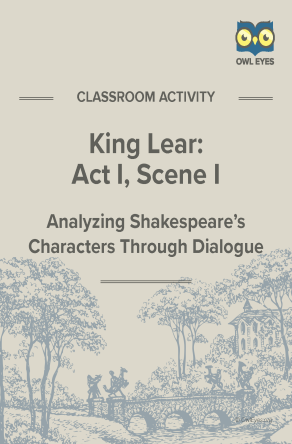King Lear Act I, Scene I Dialogue Analysis Activity
- 12 pages
- Subject: Character Analysis, Tone, Lesson Plans and Educational Resources
- Common Core Standards: RL.11-12.1, RL.11-12.5, RL.9-10.1, RL.9-10.3
Additional King Lear Resources
Product Description
The Tragedy of King Lear, one of Shakespeare’s most critically acclaimed dramas, depicts the tangled family relationships in Lear’s royal court and the consequent suffering and destruction wrought by pride, ambition, greed, and betrayal. Determined to free himself from the demands of the monarchy while retaining his power and authority, Lear foolishly divides his kingdom between his duplicitous elder daughters, Goneril and Regan, while banishing his youngest, Cordelia, when she refuses to flatter him in exchange for his grace and favor. Lear’s pride blinds him to the truth—that of his three daughters, only Cordelia loves him. The themes developed through Lear’s relationships with his daughters are underscored in the play’s subplot as Gloucester, Lear’s friend, is betrayed by Edmund, the illegitimate son he loves and trusts. Witnessing Lear’s tragedy as it unfolds, and unable to save his foolish king, is the loyal Kent, whom Lear also banishes in a fit of rage. All the major characters, apart from Edgar, Gloucester’s legitimate son, are introduced in act I, scene I, and their essential character traits are quickly established in the dialogue.
Skills: character analysis, drawing inferences from text, interpreting diction for connotative meaning
About This Document
The Owl Eyes Dialogue Analysis activity gives students an opportunity to practice examining and analyzing passages from Shakespeare’s plays. Since the theaters of Shakespeare’s time lacked elaborate sets and lighting and his scripts have sparse stage directions, dialogue is one of the few tools we can employ in understanding his characters. This worksheet focuses on the essential role of diction (word choice) in creating mood and subtext in each scene, developing characters, and establishing events in the plot. The main components of this activity include the following:
- A contextualized summary of the selected passages
- A selection of excerpts for examination
- A table with scaffolded question progression
- A step-by-step guide to activity procedure
- A complete answer key
In completing this activity, students will be able to analyze passages of dialogue to identify the speaker’s character traits, conflicts, and motivations as well as determine how diction creates mood.







